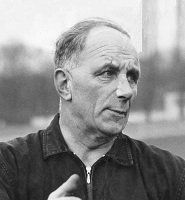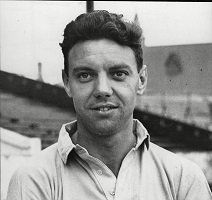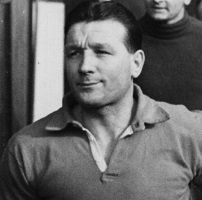Much has been written about the Liverpool Boot-Room, to which I can add little to the conventional view There are the famous pictures from the very late sixties with the six principals. But the truth is that Tom Saunders did not join until 1968, to take on the role of Youth Development Officer after half a life-time as a teacher and headmaster. And by then Ronnie Moran had only been there for two years and even then was still playing in the reserves after sixteen years in the first team, even captaincy. Thus to begin with there were just four, or is it three.
Bill Shankly signed for Liverpool on 1st December 1959. He arrived to start work a month later after the New Year break. He replaced Phil Taylor, eighteen years an Anfield player, two as a coach, and three its manager, who had led the club to fourth place in the Second Division the previous season. In fact it would have been third but for goal difference. And the start of the 1959-60 season had been far from problematic. True, two days earlier they had lost but it was away to Derby, only by one goal in five and only the sixth loss so far that season that already seen none wins and two draws. On the face of it in no way could he be considered a failure yet he would write the following about it the reasons for his not sacking but resignation.
"No matter how great has been the disappointment of the Directors at our failure to win our way back to the First Division, it has not been greater than mine. I made it my goal. I set my heart on it and strove for it with all the energy I could muster. Such striving has not been enough and now the time has come to hand over to someone else to see if they can do better."
And it was the "better" that was the problem. When in 1956 Don Welsh, the Anglo-Scot, who had captained Jimmy Seed's Charlton to consecutive promotions ultimately to the First Division before the war and two FA Cup Finals, one one, after it, the Anfield club had just finished still in the Second Division but in third place. The problem was that he had also led it to relegation two years earlier. Taylor then took it to third once more and then fourth so no improvement, therefore no top flight and with all the time a demanding Board of Directors not just looking over but sitting on the shoulder. It proved too much and permanently. He never managed again.
Thus it was that when Bill Shankly arrived mid-season he found a functioning first-team, eight Englishmen and four Scots, that would in April 1960 once more finish third, again no change, and a coaching staff that clearly knew what it was doing. However, there is Shankly the reality and Shankly the myth. Firstly it is said that he placed twenty-four of his squad on the transfer-list and all had left the club within a year. The reality is that, if it were done, it seems to have been for about five minutes and nine of the first team in 1959-60 were still there in 1960-61 and seven in promotion year 1961-62. Then later he is said to have said
"After only one match I knew that the team as a whole was not good enough. I made up my mind that we needed strengthening through the middle, a goalkeeper and a centre half who between them could stop goals, and somebody up front to create goals and score them."
It is clearly a little economic with the actuality. He might have thought it but he did or could not do it, at least not yet. In the season after his arrival only three personnel changes were made. The first was Billy Liddell, an Anfield and Scotland legend, a fixture a the club for two decades but turning thirty-nine and ready to step back. The second was another Scot, Jimmy Harrower, sometimes brilliant but erratic. And the third was a twenty-five year old, locally-born left-back, Ronnie Moran. Then in the following season just one change was made, the introduction of a twenty-year old winger, Kevin Lewis, bought from Sheffield United.
In fact it was only in that promotion season, Shankly's third in charge, that finally real moves were made with the four that came in, Ian St. John, Ian Callaghan, Gordon Milne and Ron Yeats did at least half match Shankly's words. Milne was a straight replacement of Wheeler but St. John was a forward, sometime centre-forward, if a Scottish one, and Yeats a centre-half and future captain for a decade. But the changes were made on the basis of age as much as anything. Centre-forward, Dave Hickson, was already thirty-two, as was wing-half Johnny Molyneux and right-back, Johnny Wheeler, thirty. Younger blood was needed. Callaghan was just nineteen, Milne, Yeats and St. John all twenty-three.
However, what was interesting was the sourcing of the new players. Ian Callaghan was a local boy, who had come up through the system and the other three were Scots, two Scots-born, one brought in through Shankly's connections and the the other two by others. Let me explain. Gordon Milne is the son of Jimmy and Jessie Milne, both Dundee-born. Jimmy had been a professional footballer, a one-team man, with Preston. Indeed, in 1961 he had just become Preston manager and would remain such for seven years. His son, too, had begun his senior career with Preston and Shankly and Milne senior had join that same club at almost the same time and played in the 1930s for six years alongside each other as the club had been promoted and lost and then won FA Cup Finals. They were almost family. Then there was Yeats and St. John. The latter had come from home-town Motherwell, one of "Ancell's Babes", the former from Dundee United but born in Aberdeen. Bobby Ancell, a left-back, had been born in Dumfries and between 1946 and 1950 himself played for Dundee, Aberdeen and Dundee once more.
Which takes us back to the Boot Room. When Bill Shankly arrived at Liverpool the senior training staff that he retained numbered three, like a variant on the old joke, a definite Liverpudlian, an almost Makem and certain Scot, not Shankly for he was the new-boy, the fourth. The original three were local-boy Joe Fagan, Bob Paisley and the one who never went on to manage the club, Reuben Bennett. But it was Aberdeen-born Bennett, the first Scot, who became a close personal friend of Shankly, two together from North of the Border, and who provides the links to both St. John and Yeats.
Whilst Fagan was social glue that held the Boot Room together, Paisley was the tactician and Bennett the fitness-man. A former journeyman goalkeeper in England at Hull he had played until almost forty and was as hard as nails. However, in Scotland he also had played for Queen of the South, been a team-mate of Bobby Ancell at Dundee, 'keeper to his full-back, then dabbled with management and before Liverpool had at Motherwell been assistant trainer to Ancell himself before becoming trainer at Third Lanark. They were almost family. Moreover, Bennett knew the Yeats family back in Aberdeen.
Shankly would say that the signings of Yeats and St. John were the turning-point of his time at Liverpool. They arrived just as he was teetering on the third-season, Taylor dilemma, i.e. high Board expectation but no money to back it. In fact it could be said that Bennett saved him from the possible Taylor precipice. and Shankly, indeed, Liverpool remained very loyal to him. He did not retire until 1986, on the installation of Kenny Dalglish as manager, the Double, and at the age of 72. By then he was long past fitness training but in 1971 had been given the role of Special Projects. It was his job to put together dossiers specifically on all the opposition. As such he was an integral part of the planning for nine league championships, two FA Cups, two UEFA Cups and four European Cups so job well done.
All of which leads to the conclusion that Liverpool's success under Shankly was due not to revolution but luck, for him in finding what he did when he did, and his great contribution, incremental gain through attention to detail. At his instigation on arrival training was tweaked. Already fit players became more ball-canny. A club ethos was created with the original Boot Room of four as first the focus and then as six the locus of future transmission to players and staff alike. Exercises were geared to the Shankly playing philosophy, "pass and move", another way of saying "push and run" or "Scots-style" as he did at Liverpool essentially what had already happened at Charlton with Alex McFarlane and Jimmy Seed, Leicester with the Duncans, Spurs with Peter McWilliam and his disciples, West Bromwich with one of them, Vic Buckingham, arguably Sunderland with Bill Murray as manager and Bert Johnston, trainer, and to both Manchester teams. Moreover, it was happening at precisely that same era at Burnley, Ipswich and would soon happen at Leeds, Derby and Forest, i.e. in England the effective, final, albeit partly surreptitious replacement in much of its top-flight of its native game by the superior Scots' variant.




